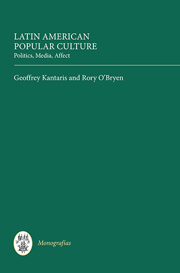Book contents
- Frontmatter
- Contents
- List of Illustrations
- Notes on Contributors
- Acknowledgements
- Introduction: The Fragile Contemporaneity of the Popular
- I Politics
- 1 ‘And where are the people?’ Genealogies of the pueblo during the Late Eighteenth and Early Nineteenth Centuries
- 2 Folktales and Fabulation in Lucrecia Martel's Films
- 3 How Popular is Cuban Popular Culture?
- 4 ‘El convertible no convertible’: Reconsidering Refuse and Disjecta Aesthetics in Contemporary Cuban Art
- II Media
- III Affect
- Index
3 - How Popular is Cuban Popular Culture?
from I - Politics
Published online by Cambridge University Press: 05 October 2013
- Frontmatter
- Contents
- List of Illustrations
- Notes on Contributors
- Acknowledgements
- Introduction: The Fragile Contemporaneity of the Popular
- I Politics
- 1 ‘And where are the people?’ Genealogies of the pueblo during the Late Eighteenth and Early Nineteenth Centuries
- 2 Folktales and Fabulation in Lucrecia Martel's Films
- 3 How Popular is Cuban Popular Culture?
- 4 ‘El convertible no convertible’: Reconsidering Refuse and Disjecta Aesthetics in Contemporary Cuban Art
- II Media
- III Affect
- Index
Summary
In this chapter I address the meaning and representativity of the term ‘Cuban popular culture’ through two rather different test-cases, the first of which is the film Aventuras de Juan Quinquín (1967) by the Cuban film director Julio García-Espinosa (b. 1926), and the second the religious social phenomenon of santería. In each case I ask the question of the extent to which the energy of popular culture is co-opted into a new (revolutionary) value-system or whether, ultimately, it escapes that hermeneutic net. It is legitimate to argue that García-Espinosa's films as much as santería as we nowadays understand the phenomenon came into being as a result of the Cuban Revolution. The experience of a revolution in Cuba in 1959 was as decisive for its generation as the French Revolution had been for European intellectuals in the 1790s. As Hobsbawm puts it: ‘It was now known that social revolution was possible; that nationals existed as something independent of states, peoples as something independent of their rulers, and even that the poor existed as something independent of the ruling classes’ (1962: 91). Hobsbawm's last point about the ‘poor’ existing ‘as something independent of the ruling classes’ is particularly relevant to the Cuban context. Hugh Thomas provides a sense of Fidel Castro's particular personal impact among the popular sectors of Cuban society soon after the Revolution:
A month after Batista's flight, Castro had established a personal hold over the Cuban masses such as no Latin American leader had ever had. […] Castro appeared so often on the television screen (the State Department was already beginning to curse the salesmen of those 400,000 sets) that he resembled less a De Gaulle or a Kennedy (others who used television to effect) than a kind of permanent confessor or a resident revolutionary medicine man. (1971: 1193)
- Type
- Chapter
- Information
- Latin American Popular CulturePolitics, Media, Affect, pp. 89 - 108Publisher: Boydell & BrewerPrint publication year: 2013

